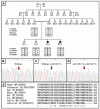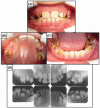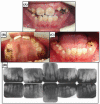MMP20 hemopexin domain mutation in amelogenesis imperfecta
- PMID: 19966041
- PMCID: PMC3318044
- DOI: 10.1177/0022034509352844
MMP20 hemopexin domain mutation in amelogenesis imperfecta
Abstract
Proteolytic enzymes serve important functions during dental enamel formation, and mutations in the kallikrein 4 (KLK4) and enamelysin (MMP20) genes cause autosomal-recessive amelogenesis imperfecta (ARAI). So far, only 1 KLK4 and 3 MMP20 mutations have been reported in ARAI kindreds. To determine whether ARAI in a family with a hypomaturation-type enamel defect is caused by mutations in the genes encoding enamel proteolytic enzymes, we performed mutational analysis on candidate genes. Mutational and haplotype analyses revealed an ARAI-causing point mutation (c.910G>A, p.A304T) in exon 6 of MMP20 that results in a single amino acid substitution in the hemopexin domain. Western blot analysis showed decreased expression of the mutant protein, but zymogram analysis demonstrated that this mutant was a functional protein. The proband and an affected brother were homozygous for the mutation, and both unaffected parents were carriers. The enamel of newly erupted teeth had normal thickness, but was chalky white and became darker with age.
Figures




Similar articles
-
Premature stop codon in MMP20 causing amelogenesis imperfecta.J Dent Res. 2008 Jan;87(1):56-9. doi: 10.1177/154405910808700109. J Dent Res. 2008. PMID: 18096894 Free PMC article.
-
Novel MMP20 and KLK4 Mutations in Amelogenesis Imperfecta.J Dent Res. 2015 Aug;94(8):1063-9. doi: 10.1177/0022034515590569. Epub 2015 Jun 29. J Dent Res. 2015. PMID: 26124219
-
Target gene analyses of 39 amelogenesis imperfecta kindreds.Eur J Oral Sci. 2011 Dec;119 Suppl 1(Suppl 1):311-23. doi: 10.1111/j.1600-0722.2011.00857.x. Eur J Oral Sci. 2011. PMID: 22243262 Free PMC article.
-
Genes and related proteins involved in amelogenesis imperfecta.J Dent Res. 2005 Dec;84(12):1117-26. doi: 10.1177/154405910508401206. J Dent Res. 2005. PMID: 16304440 Review.
-
Enamel formation and amelogenesis imperfecta.Cells Tissues Organs. 2007;186(1):78-85. doi: 10.1159/000102683. Cells Tissues Organs. 2007. PMID: 17627121 Review.
Cited by
-
Analyses of MMP20 Missense Mutations in Two Families with Hypomaturation Amelogenesis Imperfecta.Front Physiol. 2017 Apr 20;8:229. doi: 10.3389/fphys.2017.00229. eCollection 2017. Front Physiol. 2017. PMID: 28473773 Free PMC article.
-
Amelogenesis Imperfecta; Genes, Proteins, and Pathways.Front Physiol. 2017 Jun 26;8:435. doi: 10.3389/fphys.2017.00435. eCollection 2017. Front Physiol. 2017. PMID: 28694781 Free PMC article. Review.
-
MMP20 modulates cadherin expression in ameloblasts as enamel develops.J Dent Res. 2013 Dec;92(12):1123-8. doi: 10.1177/0022034513506581. Epub 2013 Sep 25. J Dent Res. 2013. PMID: 24067343 Free PMC article.
-
Genetic variation in MMP20 contributes to higher caries experience.J Dent. 2012 May;40(5):381-6. doi: 10.1016/j.jdent.2012.01.015. Epub 2012 Feb 3. J Dent. 2012. PMID: 22330321 Free PMC article.
-
Orthodontic Treatment of a Patient with Dentin Dysplasia Type I and Bilateral Maxillary Canine Impaction: Case Presentation and a Family-Based Genetic Analysis.Children (Basel). 2021 Jun 18;8(6):519. doi: 10.3390/children8060519. Children (Basel). 2021. PMID: 34207061 Free PMC article.
References
-
- Bartlett JD, Beniash E, Lee DH, Smith CE. (2004). Decreased mineral content in MMP-20 null mouse enamel is prominent during the maturation stage. J Dent Res 83:909-913 - PubMed
-
- Caterina JJ, Skobe Z, Shi J, Ding Y, Simmer JP, Birkedal-Hansen H, et al. (2002). Enamelysin (matrix metalloproteinase 20)-deficient mice display an amelogenesis imperfecta phenotype. J Biol Chem 277:49598-49604 - PubMed
-
- Fukae M, Tanabe T, Uchida T, Lee SK, Ryu OH, Murakami C, et al. (1998). Enamelysin (matrix metalloproteinase-20): localization in the developing tooth and effects of pH and calcium on amelogenin hydrolysis. J Dent Res 77:1580-1588 - PubMed
-
- Gomis-Ruth F. (2004). Hemopexin domains. In: Handbook of metalloproteins. Vol. 3 Messerschmidt A, Bode W, Cygler M, editors. Chichester: John Wiley & Sons, Ltd, pp. 631-646
Publication types
MeSH terms
Substances
Grants and funding
LinkOut - more resources
Full Text Sources

